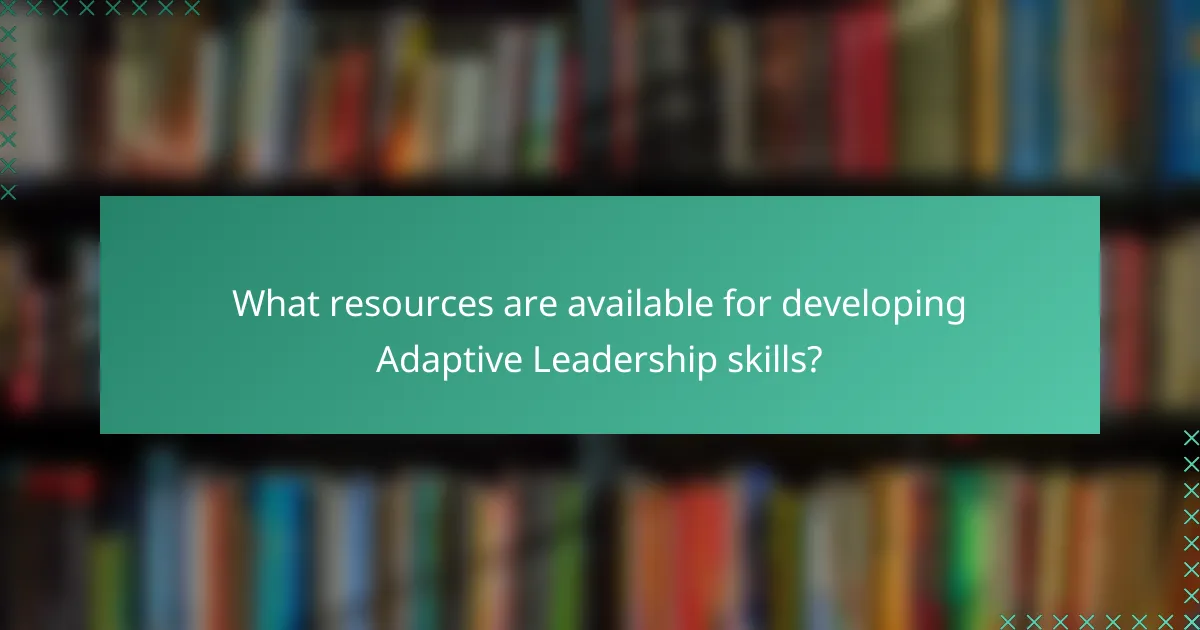Adaptive leadership is a leadership framework designed to help individuals effectively navigate complex challenges by adapting strategies to changing environments. This approach distinguishes between technical challenges, which can be addressed with existing knowledge, and adaptive challenges that require new learning and behavioral changes. Developed by Ronald Heifetz and Marty Linsky at Harvard University, adaptive leadership emphasizes resilience, flexibility, and team engagement in problem-solving. The article explores the application of adaptive leadership across various contexts, including organizational settings, educational institutions, healthcare, and non-profit organizations, highlighting its impact on team performance and resilience. Additionally, it outlines resources available for developing adaptive leadership skills, such as books, online courses, workshops, and coaching, which enhance leaders’ capabilities in managing dynamic environments.

What is Adaptive Leadership?
Adaptive leadership is a leadership framework that enables individuals to navigate complex challenges. It emphasizes the ability to adapt strategies in response to changing environments. This approach encourages leaders to engage their teams in problem-solving. It focuses on the distinction between technical and adaptive challenges. Technical challenges can be solved with existing knowledge and skills. Adaptive challenges require new learning and changes in behavior. The adaptive leadership model was developed by Ronald Heifetz and Marty Linsky at Harvard University. Their work highlights the importance of resilience and flexibility in leadership.
How does Adaptive Leadership differ from traditional leadership models?
Adaptive Leadership focuses on navigating complex and changing environments, unlike traditional leadership models that emphasize stable hierarchies and control. Traditional models often rely on established rules and procedures. They prioritize authority and predictability. In contrast, Adaptive Leadership encourages flexibility and learning. It values collaboration and responsiveness to emerging challenges. Adaptive leaders engage their teams in problem-solving. They foster an environment where experimentation is encouraged. This approach is essential in today’s fast-paced world, where adaptability is crucial for success. Research by Heifetz and Laurie (2001) highlights how Adaptive Leadership is necessary for addressing adaptive challenges, which require new strategies rather than technical solutions.
What are the key principles of Adaptive Leadership?
The key principles of Adaptive Leadership include the ability to distinguish between technical and adaptive challenges. Adaptive Leadership emphasizes the importance of engaging others in problem-solving. It requires leaders to create a safe environment for experimentation. Leaders must also foster collaboration among diverse groups. Another principle is the need for continuous learning and adaptation. Leaders should encourage feedback and reflection to improve processes. Effective communication is crucial in conveying vision and direction. Finally, leaders must be willing to take risks and embrace uncertainty. These principles are essential for navigating complex and changing environments.
Why is Adaptive Leadership important in today’s dynamic environments?
Adaptive Leadership is crucial in today’s dynamic environments because it enables leaders to navigate complex challenges effectively. This leadership style promotes flexibility and responsiveness to changing circumstances. Adaptive leaders assess their environments and adjust strategies accordingly. They encourage collaboration and innovation among team members. Research shows that organizations led by adaptive leaders are more resilient during crises. For instance, a study by Heifetz and Laurie (2001) highlights that adaptive leadership fosters problem-solving in unpredictable situations. This adaptability leads to improved organizational performance and employee engagement. Thus, Adaptive Leadership is essential for success in rapidly evolving contexts.
What essential skills are required for Adaptive Leadership?
Essential skills required for Adaptive Leadership include emotional intelligence, systems thinking, and the ability to foster collaboration. Emotional intelligence allows leaders to understand and manage their emotions and those of others. Systems thinking enables leaders to see the big picture and understand complex interdependencies. Collaboration fosters teamwork and encourages diverse perspectives. These skills help leaders navigate challenges in dynamic environments effectively. Research indicates that leaders with high emotional intelligence are more successful in managing change (Goleman, 1998). Additionally, systems thinking is crucial for addressing multifaceted problems (Senge, 1990).
How do emotional intelligence and self-awareness contribute to Adaptive Leadership?
Emotional intelligence and self-awareness are crucial for adaptive leadership. They enable leaders to understand their own emotions and the emotions of others. This understanding fosters better communication and collaboration within teams. Leaders with high emotional intelligence can navigate complex social dynamics effectively. Self-awareness allows leaders to recognize their strengths and weaknesses. This recognition leads to more informed decision-making. Research indicates that emotionally intelligent leaders are more successful in managing change. A study by Goleman et al. (2002) highlights that emotional intelligence is a key predictor of leadership effectiveness. Thus, emotional intelligence and self-awareness significantly enhance adaptive leadership capabilities.
What role does effective communication play in Adaptive Leadership?
Effective communication is crucial in Adaptive Leadership. It enables leaders to convey vision and direction clearly. Effective communication fosters collaboration among team members. It helps in understanding diverse perspectives and addressing challenges. Leaders who communicate well can inspire trust and engagement. This trust is essential for navigating complex environments. Research indicates that organizations with strong communication practices are more adaptable. A study by the Institute for Public Relations found that effective communication can enhance organizational resilience.
How can leaders develop flexibility and resilience in their leadership style?
Leaders can develop flexibility and resilience in their leadership style by embracing adaptive strategies. They should actively seek feedback from their teams to understand diverse perspectives. This practice fosters an environment of open communication and trust. Leaders can also engage in continuous learning to stay informed about industry changes and challenges. By attending workshops and training sessions, they enhance their skill sets. Additionally, leaders must practice self-reflection to assess their responses to stress and change. Research shows that self-reflection improves emotional intelligence, a key trait for resilient leaders. Finally, cultivating a supportive network helps leaders navigate challenges effectively. A strong network provides resources and advice during difficult times.
What challenges do Adaptive Leaders face in dynamic environments?
Adaptive leaders face several challenges in dynamic environments. Rapid changes in market conditions can disrupt established strategies. They must navigate uncertainty and ambiguity, which complicates decision-making. Resistance to change from team members can hinder progress. Additionally, maintaining clear communication is crucial yet challenging in fast-paced settings. Resource constraints may limit their ability to implement necessary adaptations. Balancing short-term and long-term goals adds complexity to their leadership role. Lastly, fostering a culture of innovation while managing risks is a significant challenge. These factors collectively impact the effectiveness of adaptive leaders in dynamic environments.
How do leaders navigate uncertainty and complexity?
Leaders navigate uncertainty and complexity by employing adaptive leadership strategies. They assess the situation to identify key challenges and opportunities. Effective leaders communicate clearly to align their teams with a shared vision. They encourage collaboration among team members to foster innovative solutions. Leaders also remain flexible, adjusting their strategies as new information emerges. They utilize data-driven decision-making to minimize risks. Research indicates that adaptive leaders are more successful in volatile environments (Heifetz & Laurie, 1997). This adaptability enhances organizational resilience and performance during uncertain times.
What are common pitfalls for Adaptive Leaders?
Common pitfalls for adaptive leaders include resistance to change, lack of clarity in vision, and failure to engage team members. Resistance to change can hinder progress and innovation. A lack of clarity in vision can lead to confusion and misalignment among team members. Failure to engage team members can result in low morale and decreased productivity. Additionally, adaptive leaders may struggle with over-reliance on their own expertise, which can limit diverse perspectives. They might also experience difficulties in managing conflict effectively, impacting team dynamics. Lastly, neglecting self-care can lead to burnout, reducing their effectiveness as leaders.
How can leaders manage resistance to change effectively?
Leaders can manage resistance to change effectively by fostering open communication. This involves sharing the rationale behind changes clearly and transparently. Engaging employees in the change process helps to build trust. Leaders should actively listen to concerns and feedback from their teams. Providing support and resources during transitions is crucial. Training programs can equip employees with necessary skills. Recognizing and rewarding adaptability encourages a positive response to change. Research shows that organizations with strong communication strategies experience less resistance.

How can Adaptive Leadership be applied in various contexts?
Adaptive Leadership can be applied in various contexts by promoting flexibility and responsiveness to changing environments. In organizational settings, leaders can encourage team collaboration during crises. This helps to address complex challenges effectively. In educational institutions, adaptive leadership fosters innovative teaching methods that cater to diverse learning needs. Healthcare settings utilize adaptive leadership to improve patient care through collaborative decision-making. Non-profit organizations apply adaptive leadership to navigate funding challenges and community needs. Each context benefits from leaders who can assess situations and adapt strategies accordingly. Research shows that adaptive leadership enhances team performance and resilience in unpredictable circumstances.
What are some real-world examples of successful Adaptive Leadership?
Successful examples of Adaptive Leadership include the leadership of Howard Schultz at Starbucks. Schultz transformed Starbucks by adapting the business model during economic downturns. He focused on employee engagement and customer experience, which revitalized the brand. Another example is Paul Polman, former CEO of Unilever. Polman shifted Unilever towards sustainable practices, adapting to changing consumer values. His leadership resulted in significant growth while promoting social responsibility. Additionally, the response of New Zealand Prime Minister Jacinda Ardern during the COVID-19 pandemic exemplifies Adaptive Leadership. Ardern’s decisive actions and clear communication helped navigate the crisis effectively. Each of these leaders demonstrated the ability to adapt strategies to meet evolving challenges and stakeholder expectations.
What lessons can be learned from these success stories?
Success stories in adaptive leadership highlight the importance of flexibility and responsiveness. Leaders must adjust their strategies based on changing circumstances. Effective communication is crucial for fostering collaboration and trust among team members. Embracing diverse perspectives can lead to innovative solutions. Learning from failures is essential for growth and improvement. Building resilience helps teams navigate challenges more effectively. These lessons demonstrate the value of a proactive approach in dynamic environments.
How do different industries implement Adaptive Leadership strategies?
Different industries implement Adaptive Leadership strategies by fostering flexibility and responsiveness to change. In healthcare, leaders adapt by integrating patient feedback to improve services. The technology sector emphasizes iterative development and agile methodologies to respond to market demands. In education, adaptive leaders promote personalized learning to cater to diverse student needs. The nonprofit sector often pivots strategies based on community feedback and funding changes. Retail industries utilize adaptive leadership to adjust inventory and marketing strategies based on consumer trends. Each industry showcases unique methods tailored to their specific challenges and environments, all while maintaining core adaptive leadership principles.
What best practices can enhance Adaptive Leadership effectiveness?
Fostering a collaborative environment enhances Adaptive Leadership effectiveness. Encouraging open communication allows leaders to gather diverse perspectives. This inclusivity leads to better problem-solving and innovation. Providing ongoing feedback helps leaders and teams adjust strategies in real-time. Emphasizing continuous learning enables leaders to adapt to changing circumstances. Building resilience within teams prepares them for unexpected challenges. Establishing clear goals aligns team efforts and enhances focus. Encouraging experimentation fosters a culture of adaptability and growth. These practices collectively strengthen Adaptive Leadership capabilities.
What strategies can leaders use to foster a culture of adaptability?
Leaders can foster a culture of adaptability by promoting open communication. This encourages team members to share ideas and feedback. Providing training and development opportunities enhances employees’ skills. Leaders should model adaptable behavior themselves. This sets a standard for the team to follow. Encouraging collaboration across departments breaks down silos. This promotes a more flexible organizational structure. Recognizing and rewarding innovative solutions motivates employees to embrace change. Research shows that organizations with adaptable cultures are more resilient in dynamic environments.
How can leaders encourage collaboration and innovation among teams?
Leaders can encourage collaboration and innovation among teams by fostering an open communication environment. This involves creating spaces for team members to share ideas freely. Leaders should actively solicit input from all team members. Regular brainstorming sessions can stimulate creative thinking. Providing resources and tools that facilitate collaboration is essential. Leaders can also recognize and reward innovative contributions. Empowering teams with autonomy can increase ownership of projects. A culture that embraces risk-taking encourages experimentation and learning from failures. These practices lead to higher engagement and improved team performance.

What resources are available for developing Adaptive Leadership skills?
Resources for developing Adaptive Leadership skills include books, online courses, workshops, and coaching. Notable books include “Leadership on the Line” by Ronald Heifetz and Marty Linsky. This book outlines practical approaches to adaptive challenges. Online platforms like Coursera and edX offer courses specifically on adaptive leadership. Workshops by organizations such as the Center for Creative Leadership provide hands-on experiences. Additionally, executive coaching can help individuals apply adaptive leadership principles in real-world scenarios. Research indicates that these resources enhance leaders’ ability to navigate complex environments effectively.
What training programs and workshops are recommended for aspiring Adaptive Leaders?
Recommended training programs for aspiring Adaptive Leaders include the Adaptive Leadership Workshop by Harvard Kennedy School. This program focuses on practical strategies for navigating complex challenges. Another option is the Leadership Development Program by the Center for Creative Leadership. It emphasizes self-awareness and adaptability in leadership roles. The Leadership Challenge Workshop is also beneficial, providing tools for inspiring and engaging teams. Additionally, the Leadership in a Complex World program by the University of Michigan offers insights into managing change and uncertainty. These programs are recognized for their effectiveness in developing adaptive leadership skills.
How can mentorship and coaching support leadership development?
Mentorship and coaching significantly enhance leadership development by providing personalized guidance and feedback. These processes foster skill enhancement through experiential learning. Mentors share their experiences, offering insights that help mentees navigate challenges. Coaching focuses on specific skill sets, enabling leaders to refine their abilities. Research shows that organizations with mentoring programs report higher employee satisfaction and retention rates. A study by Allen et al. (2004) found that mentees are more likely to advance in their careers. This progression is attributed to increased confidence and improved decision-making skills. Consequently, mentorship and coaching create a supportive environment that accelerates leadership growth.
What books and materials are essential for understanding Adaptive Leadership?
“Adaptive Leadership” by Ronald Heifetz and Marty Linsky is essential for understanding the concept. This book introduces key principles of adaptive leadership. It emphasizes the importance of distinguishing technical problems from adaptive challenges. “The Practice of Adaptive Leadership” by Heifetz, Linsky, and Alexander Grashow provides practical tools and frameworks. This material focuses on applying adaptive leadership in real-world scenarios. Additionally, “Leadership on the Line” by Heifetz and Linsky addresses the risks involved in leading adaptive change. These texts collectively provide a comprehensive understanding of adaptive leadership theories and practices.
How can individuals assess their own Adaptive Leadership capabilities?
Individuals can assess their own Adaptive Leadership capabilities by reflecting on their problem-solving skills and adaptability in various situations. They should evaluate their ability to navigate complex challenges and foster collaboration among team members. Self-assessment tools, such as 360-degree feedback, can provide insights from peers and subordinates. Additionally, individuals can analyze their responses to past leadership scenarios to identify strengths and areas for improvement. Engaging in leadership training programs can further enhance self-awareness and leadership skills. Research indicates that self-reflection and feedback are crucial for effective leadership development.
What self-assessment tools can help identify strengths and areas for improvement?
Self-assessment tools that can help identify strengths and areas for improvement include the StrengthsFinder assessment, the Myers-Briggs Type Indicator (MBTI), and the 360-Degree Feedback tool. The StrengthsFinder assessment identifies individual strengths based on responses to a series of questions. It provides insights into one’s natural talents and how to leverage them effectively. The Myers-Briggs Type Indicator categorizes personality types, helping individuals understand their preferences and behaviors. This understanding can guide personal development and interpersonal interactions. The 360-Degree Feedback tool gathers input from peers, supervisors, and subordinates. It offers a comprehensive view of an individual’s performance and areas that may need improvement. These tools are widely used in personal and professional development contexts. They are backed by research in psychology and organizational behavior, demonstrating their effectiveness in promoting self-awareness and growth.
How can feedback from peers enhance Adaptive Leadership skills?
Feedback from peers enhances Adaptive Leadership skills by providing diverse perspectives and insights. Peers can identify strengths and weaknesses in leadership approaches. This feedback fosters self-awareness, allowing leaders to adjust their strategies. Additionally, peer feedback encourages collaboration and open communication. It promotes a culture of continuous learning and improvement. Research indicates that leaders who seek feedback are more effective in navigating change. A study by London and Smither (1999) found that feedback significantly improves leadership effectiveness. Thus, peer feedback is crucial for developing Adaptive Leadership skills.
Adaptive Leadership is a leadership framework that emphasizes the ability to navigate complex challenges by adapting strategies in response to changing environments. This article explores the key principles of Adaptive Leadership, including the distinction between technical and adaptive challenges, the importance of emotional intelligence, and effective communication. It also addresses the essential skills required for adaptive leaders, the challenges they face in dynamic environments, and real-world success stories that illustrate the application of adaptive leadership strategies across various industries. By examining best practices and available resources, the article provides a comprehensive understanding of how Adaptive Leadership can enhance organizational resilience and performance.
